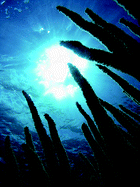Given the potential for adverse effects of ocean dredging on marine organisms, particularly benthic primary producer communities, the management and monitoring of those activities which cause elevated turbidity and sediment loading is critical. In practice, however, this has proven challenging as the development of water quality threshold values, upon which management responses are based, are subject to a large number of physical and biological parameters that are spatially and temporally specific. As a consequence, monitoring programs to date have taken a wide range of different approaches, most focusing on measures of turbidity reported as nephelometric turbidity units (NTU). This paper presents a potential approach in the determination of water quality thresholds which utilises data gathered through the long-term deployment of in situ water instruments, but suggests a focus on photosynthetic active radiation (PAR) rather than NTU as it is more relevant biologically and inclusive of other site conditions. A simple mathematical approach to data interpretation is also presented which facilitates threshold value development, not individual values of concentrations over specific intervals, but as an equation which may be utilized in numerical modelling.

You have access to this article
 Please wait while we load your content...
Something went wrong. Try again?
Please wait while we load your content...
Something went wrong. Try again?


 Please wait while we load your content...
Please wait while we load your content...